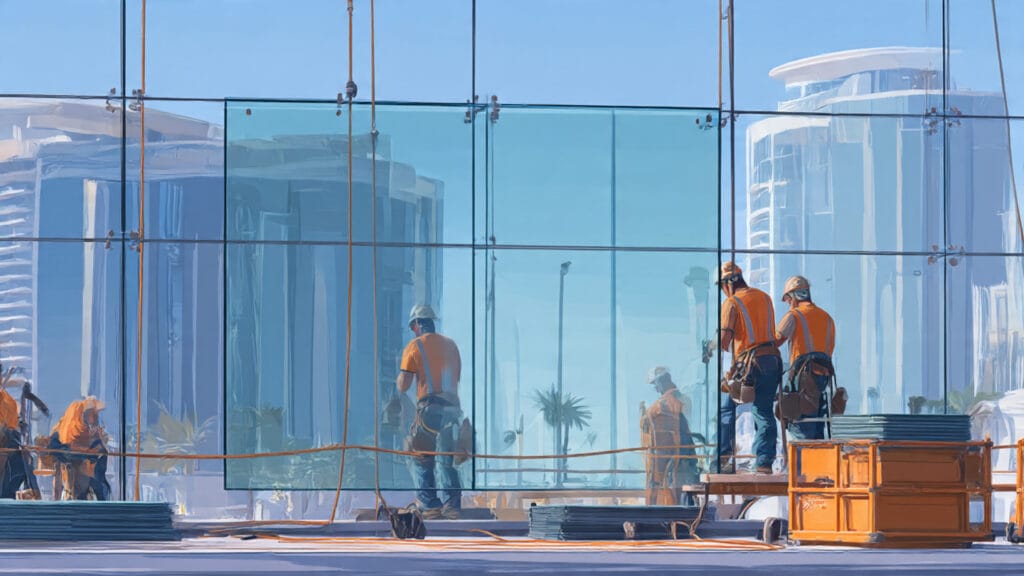Commercial glass enhances both the strength and appearance of a building. When replacing it, the new glass must maintain the original form and functionality. Before selecting a replacement, it’s key to evaluate factors such as durability, safety, design, and energy performance. Here’s more information to help navigate the commercial glass replacement process:
Architectural Glass
Architectural glass appears on facades, curtain walls, and storefronts, offering transparency while maintaining structural protection. When replacing glass, installers match the thickness and coating type to preserve both appearance and performance. Low-emissivity coated insulated glass units can improve a building’s energy efficiency and temperature regulation. Replacing a retail facade with similar reflective glass helps maintain daylight control. Proper sealing and precise alignment prevent leaks and condensation, offering durability and visual quality. Choosing the right architectural glass supports cohesive building design, enhances sustainability, and strengthens the overall structure.
Restoration Glass
Restoration glass conserves the original beauty of historical or heritage buildings while enhancing safety and longevity. Some old buildings have antique, hand-blown, or wavy panes that must be replaced very carefully. Contractors balance authenticity with performance standards by selecting tempered or laminated restorations.
Carefully recording sightlines, glass thickness, and frame finishes verifies that the new glass integrates seamlessly with the existing architecture. This replacement process preserves the building’s design integrity while adding modern weather and impact resistance. Using restoration glass maintains historical authenticity without sacrificing occupant safety or energy efficiency.
Patterned and Colored Glass
Patterned glass adds privacy, diffuse light, and texture to commercial interiors like offices and hotels. It is created by stamping or rolling designs onto hot glass, giving it both design and utility. Replacement glass should match the original pattern depth, light transmittance, and orientation. Vertical fluted or geometric designs can maintain privacy without fully blocking natural light. Patterned glass also reduces glare, making it ideal in meeting rooms, partitions, and display areas. Patterned glass helps create balanced spaces by combining visual interest with controlled natural light, enhancing both style and functionality.
Also known as tinted or body-colored glass, colored glass helps prevent overheating in houses and enhances aesthetic appeal. It is made by impregnating the glass mixture with metallic oxides or special surface coatings. When replacing panels, evaluate both visible light transmission and the solar heat gain coefficient to maintain a comfortable and balanced interior environment.
A west-facing storefront may incorporate bronze-colored glass to limit glare and reduce solar heat gain. The color, hue intensity, and reflective qualities should remain consistent across the entire facade to maintain visual continuity. Colored glass can also support branding by reflecting a company’s color scheme in the overall architectural design.
School Glass
School glass prioritizes safety, visibility, and strength in educational settings where usage and impact are frequent. These buildings will often require laminated or tempered glass that is resistant to breakage when pressure is applied. The commercial glass replacement should comply with school building codes regarding fire ratings and energy standards.
Double-glazed low-emissivity panels can improve comfort and reduce noise in classrooms. Safety glass holds fragments together if broken, reducing the risk of injury. Accurate installation and careful measurement help maintain visibility and overall building performance, supporting safe and energy-conscious learning environments.
Glass Railings
In commercial buildings and hospitality venues, glass railings and entry doors seamlessly blend transparency and structural strength. They are typically made from tempered or laminated glass to increase strength and resist shattering. Glass railings achieve both safety and aesthetic continuity when installed with reinforced fittings that meet building code requirements. Using tempered or laminated panels offers strength and impact resistance. Properly installed glass railings also maximize natural light, creating a bright, open, and modern appearance for interior and exterior spaces.
Schedule Your Commercial Glass Replacement
Selecting the right glass depends on the building’s purpose, location, and environmental conditions. High-traffic spaces such as schools or retail centers require glass with a strong safety rating to resist impact. Office buildings may prioritize thermal performance, acoustic insulation, and visual comfort through specialized coatings. Local regulations and maintenance requirements also influence glass specifications for businesses and public buildings. A professional site assessment determines glazing needs, load requirements, and frame compatibility when starting the process of getting a commercial glass replacement. Reach out to an installer to schedule your glass replacement services today.


